Pedodontics (Children dentistry)
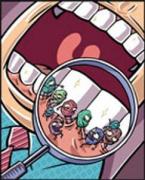 Why do childrens teeth decay?
Why do childrens teeth decay?
Milk teeth compared to permanent teeth contain more organic matrix,because of thatthey tend to decayfaster and easier.
Children mostly can not interprete the early signs of tooth decay like hot and cold sensitivity or the slight pain on time.Unfortunately they become aware of the fact when they have enourmous pain a when it is too late.
Children can not take care of their oral hygiene like adults. It is the childs maual skills, his curiosity and their parents attitude which determines the brushing habbit of the child.
Especially the biggest mistake some moms do is to dip the soother and the baby bottles tip into sugar,jam etc. and to feed their babies during sleep with milk with sugar or juice which they easily get accustomed to. This irregularity in nutrition makes teeth more prone to decay.
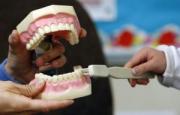 Can caries formation be prevented?
Can caries formation be prevented?
Till now no vaccine or pill have been developed. But some materials trying to deminish the number of carious teeth are nowadays on the market,one of them is the fissure sealent .Caries often start at the little grooves of the chewing surfaces which we call fissures. By applying those sealents on those grooves we manage to isolate food ,microrganisms from those surfaces. This procedure is done after the first primary permanent molars and then the premolars erupt beginning with the age of 6.
Another way to prevent caries is to srenghten the teeth against caries by appliying topical fluor , which makes the teeth stronger and more caries resistant.
Do we need to treat the primary milk teeth?
Milk teeth that are not treated cause pain,bad odor,chewing difficulties,nutrition problems and bad appearance.Teeth that are not treated in this period may cause some systemic diseases like heart rheumatism and eventually by early extractions orthodontic problems may also be encountered. That’s why without saying “anyway they will fall off and new teeth will come” milk teeth need to be treated.
In Pedodontics there are 2 approaches
I.Treatment Approach
II.Preventive Approach
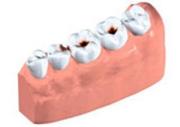 Caries
Caries
At children caries is a problem which you widely find.Brushing habbit that could not be acquired or the unremovable bacterial plaque cause caries at children.These are either treated with temporary or permanent fillings.For highly damaged teeth instead of pulling it out a milk tooth crown is done to prevent early extraction.
Fracture
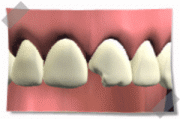 At accidents where childrens teeth are damaged without loosing time an itervention has to be planned.Children very frequently fall or hit. As a result of it they may damage their front teeth that consequently will make them very uncomfortable for the coming years and let them visit the the dentist very frequently.It is important to diagnose the problem correctly. According the anemnesis the adequate treatment is going to be performed.
At accidents where childrens teeth are damaged without loosing time an itervention has to be planned.Children very frequently fall or hit. As a result of it they may damage their front teeth that consequently will make them very uncomfortable for the coming years and let them visit the the dentist very frequently.It is important to diagnose the problem correctly. According the anemnesis the adequate treatment is going to be performed.
Dental traumas are the most common problems in such accidents. During some sport activities or after falls dental fractures may happen due to traumas in the face or mouth region. Depending on how strong the trauma the tooth may either partially or totally fracture or it may also be avulsed.Subsequently there may be some damage in the pulp of the tooth which may lead also to pulpal death.In this situation the tooth may discolour in the long run.For situations like that especially for children who are doing sports mouth guards can be fabricated ,which helps a lot to reduce the damage during the accidents to a great extent. Children doing sports should be advised to wear the the plastic generally tranparent sleeves over their teeth before they start to exercise.
Trauma
If the front tooth and/or teeth have avulsed or fractured
Please by wetting a clean gauze with your saliva put your total tooth or its fragment or fragments and go directly to your doctor.If you can’t go immeadetely wet your gauze with saline solution that you get from a pharmacy and try to reach out a doctor. The most ideat time to start the treatment is within 1 hour. If the situation is available either he will reimplant the tooth back in place or bond the fragment with a special tecnique to its original place. With a meticilous application and a proper oral hygine thereafter the child is going to maintain his tooth for lifelong.
What if the broken fragmeny gets lost?
If the fragment is small , then a composite filling matching color and shape is done.Composite fillings durability in the mouth are limited,they easiliy get stained by coke tea,coffee etc and need to be eather after some time repolished or sometimes they may need to be redone according oral hygiene and food and beverage consumption habbits.
If the fragment is larger, then if it makes up half or more than a half of the tooth structure and if the patient is older than 17 laminate veneers are indicated. Porcelain laminates are thin shell like restorations which are esthetic and durable restorative solutions.
For people younger than 17 the porcelain laminates are not indicated since the grow of the teeth and jaw have not been completed. In those situations composite laminates can be done without forgettig the discoloration problem.
What if after trauma everything seems normal?
Definately a thoroughly exam and radipologic exams are to be made. If after clinical and radiological examination there is no evidence periodical x-rays have to be taken and compared to the old ones. By doing it a possible change in the radigrafic view of the pulpal tissue may be detected. In some cases the pulpal change goes along with discoloration which should be treated immeadetely with root canal therapy to avoid complications that may lead to the loss of the tooth.
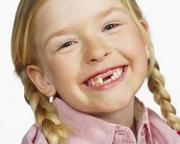 Extraction
Extraction
In some cases caries reaches the pulp of he milk tooth and through the canals of the root the inflamation spreads to the bone. The kids face starts swelling accompanied by a strong pain. In those sitations it is not wise to keep the tooth for the sake of the kids health. These teeth are extracted. Especially if it is a primary milk tooth and time is almost up for the permanent tooth to erupt doesnt matter, but if the permanent tooth needs more time to erupt a space maintainer has to be done in order to prevent any orthodontic problems that may appear.
If something like that happens to a permanent tooth every other option has to be looked upon and if there is nothing else to be done extraction has to be considered. If the age of the child permits right after the extraction orthodontics has to be applied to close the space and to avoid furder maloclusions. If let untreated the teeth adjecent to the extracted tooth start migrating to the space and the tooth occluding with it start migration to the opposing arch s o that we now face amalocclusion Kalıcı bir dişte ise çekim işleminden önce bu karar defalarca gözden geçirilmeli ve gerçekten yapılacak hiçbir şey kalmadığı durumlarda çekim düşünülmelidir. Daimi dişler çekildikten sonra, çocuğun yaşı uygun ise hemen ortodontik tedaviye başlanarak bu boşluk diğer dişlerle kapatılmalı ve alt-üst dişler arasında doğru bir kapanış ilişkisi sağlanmalıdır. Çekilmiş bir daimi dişin yeri öylece bırakıldığında yandaki dişler bu boşluğa doğru eğilirler. Boşluğun karşısındaki diş boşluğa uzar ve bir diş yüzünden ağzın bütün dengesi bozulabilir.
Cleaning
The plaque accumulation should be cleaned out by the dentist if it is no longer possible to get rid of it by regular toothbrushing, which will also eliminate the risk of the plaque to transform into tartar or cause caries. At the same appointment oral hygiene instructions and caries protection informations should be given to the kid and a control appointment should be arranged.
II. Preventive Approaches
Today dentistry is much more focused in preventive approaches compared to the past. Preventive dentistryplays a ver important role especially at children. Since the applications in the field of preventive dentistry are noninvasiv,nonpainful easily done and cheap it is prefered that childrens first encountering with the dentists is through preventive dentistry applications.
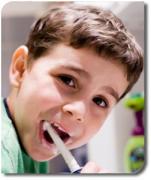 1. Hygiene Instructions
1. Hygiene Instructions
To accomplish a proper oral hygiene requires a porper knowledge about it.Starting from tooth brushing techniques and dental floss usage to nutrition habbits evaluation and last but not the least containing the brief instructions about the whole oral hygiene concept is a pachage that has to be delivered to the patient. This instructions should also be taken into consideration by adults and not only by children..
2. Topical Fluor application
Fluoride is a natural mineral that we take from the drinking water and many other foods. For many years investigators tried to figure out the reason for quantitatively less decay ratios in different areas and found out that areas where drinking water was highly flouridated people there have better decay indices compared to other locations with lesser flourid content. This made them conclude that fluoride makes enamel more resistant to decay.At first it was thought to optimally flouridate the whole city water system and executed in some areas but later it turned out to cause other side effects and it was abondened and the fluorid ratio was decreased.
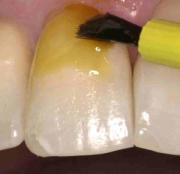 In recent years the studies have shown that topical fluoride applications are more important and that flouride tablets the pregnant women and the the newborns take after 6 monts of age are not as usefull as it was thought to be. Enamels crystallike structure after topically fluoride application gets more resistant against acids so that it barely gets rough and the decay formation is more difficult to take place. Topical fluoride applications can be started with the age of 3 and subsequently every 6 months the application has to be repeated. It is a very easy and and painless application.Fluoride that is stored on the tooth surfaces will make teeth healthier and stronger.
In recent years the studies have shown that topical fluoride applications are more important and that flouride tablets the pregnant women and the the newborns take after 6 monts of age are not as usefull as it was thought to be. Enamels crystallike structure after topically fluoride application gets more resistant against acids so that it barely gets rough and the decay formation is more difficult to take place. Topical fluoride applications can be started with the age of 3 and subsequently every 6 months the application has to be repeated. It is a very easy and and painless application.Fluoride that is stored on the tooth surfaces will make teeth healthier and stronger.
3. Fissure Sealant
The occlusal surfaces of the molar teeth are not flat, there are tiny grooves and mounds which we call pits and fissures. These areas are exremely narrow and since food get stuck at those areas decays usually start from there.In order to prevent caries by further food and microorganism accumulalation a flowable filling material is used to cover these spaces. Fist the surface is cleaned and then the fissure sealent is applied and light activated,excess is removed and eventually it is polished. With sealants %70 of the occlusal surface decays can be eleminated. Although they stay intact for a long time they frequently have to be reevaluated especially at people with bad habbits such as bruxig or chewing ice. The most ideal time for the sealent application is right after the eruption of the permanent molars.,which take place around 6 years of age. After the other molar and premolar teeth erupt the application is done for them as well. It is better to have the sealent done within in 1-2 year after the eruption.Because as long as the procedure is delayed the chance of caries goes high and instead of sealents filing hve to be applied. It can also be applied toadults but the revenue you get from children is higher and is more profitable. It tis absolutely very simple and painless. procedure.
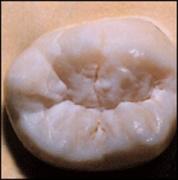
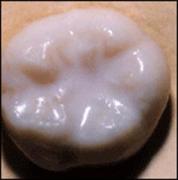
How is it done?
Before the application of the sealent the surfaces have to thoroughly cleaned and all plaque has to be removed. For that purpose teeth are brushed with special solutions and then dried. Afterwards the enamel is roughened with a gel and then a bonding agent is applied,lightactivated.As the last step the sealent is applied with abrush to make sure it infiltrates in the fissures and tthe again lightactivated. Later the bite is checked and the varnish is covered on the top.
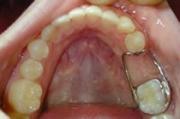 4. Space Maintainer
4. Space Maintainer
Due to trauma or decay sometimes the milk teeth are lost early and the neighbouring teeth start migrating to the space left before the permanent tooth is ready erupt in the primary tooths position and close that space. As a matter of fact the occluding tooth may start moving to the opposite arch as well. If the situation is left untreated it may lead to maloclusions where permanent teeth can not find space to errupt and crowding or more severe orthodontic problems develop..
Problems that may come up even at the loss of one milk tooth:
- Teeth will migrate and malpositions will develop which makes it difficult to clean the area
- Cheweing will be difficult
- More serious rthodontic problems will come up
Some milk teeth are supposed to say till 12 years of age. Generally with 12 years all permanent teeth exept the wisdom teeth are supposed to erupt. Milk teeth that erupted during babyhood are difficult to maintainwithout any problem till 12 years of age. That is why the little metallic device is fabricated according the kids mouth and keeps the space left by the early lost of the primary tooth until the permanent tooths eruption time.These devices can be fixed or removable depending on the case.
How can we take care of the space maintainer?
- Avoid sticky foods,candies and gums
- Do not play around with your tongue or fingers
- Keep it clean by regularly brushing and flossing
- Go to check-up evert 6 months
Oral Hygiene at Babies
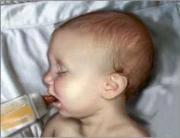 Breastfeeding the babies for at least 6 months will help soft tissue and muscle functions in the oral region to develop normally. When breastfeeding can not be done special baby bootles supporting oral tissues anatomically have to be used.The babies are supposed to be accustomed to use normal cups and spoons from 1 year on.Babybottles can be used latest till 2 years of age.Thumbsucking and soothers should not allowed after 2-2.5 years of age.If the thumbsucking continues the underlying reasons have tobe found out and managed to be quited latest till 3-6 years of ages. One last thing that has to be underlined is wrong inhalation.Children who are only mouth breathers may have problems with jaw developments and it often happens during sleep.If this is the case an ear nose and throat specialist has to take care of the situation.
Breastfeeding the babies for at least 6 months will help soft tissue and muscle functions in the oral region to develop normally. When breastfeeding can not be done special baby bootles supporting oral tissues anatomically have to be used.The babies are supposed to be accustomed to use normal cups and spoons from 1 year on.Babybottles can be used latest till 2 years of age.Thumbsucking and soothers should not allowed after 2-2.5 years of age.If the thumbsucking continues the underlying reasons have tobe found out and managed to be quited latest till 3-6 years of ages. One last thing that has to be underlined is wrong inhalation.Children who are only mouth breathers may have problems with jaw developments and it often happens during sleep.If this is the case an ear nose and throat specialist has to take care of the situation.
